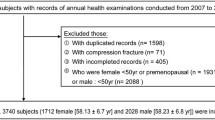Abstract:
An inappropriate reference range for peak bone mineral density (BMD) may result in identification of an incorrect proportion of subjects with osteopenia and osteoporosis at dual-energy X-ray absorptiometry (DXA). In this study, we assessed the prevalence of low BMD in Turkish young adults with respect to local population reference range T-scores and the US reference range T-scores. The BMD values of lumbar spine (L1–L4) and proximal femur (femoral neck, intertrochanter, trochanter, Ward”s triangle and total) were measured by DXA in 323 healthy young adults (171 women, 152 men) aged 19–25 years. The World Health Organization criteria for the diagnosis of osteopenia (−2.5 <T-score <−1) and osteoporosis (T-score ≤−2.5) were applied. In women, the means of the US reference range T-scores were significantly lower than zero at the spine and proximal femoral sites (p<0.0001). In men, the means of the US reference range T-scores were significantly lower than zero at the spine, femoral neck, intertrochanter, total femur (p<0.0001) and trochanter (p<0.05), but not at Ward”s triangle (p=0.92). When the diagnoses were based on local population reference range T-scores instead of the US reference range T-scores, the prevalence of low BMD (T-score <−1) in women fell from 50.3% to 14.0% at the lumbar spine and from 60.8% to 14.6% at the femoral neck, and in men from 42.8% to 15.8% at the lumbar spine and from 30.9% to 17.1% at the femoral neck. Our data suggest that individual populations should use their own reference range T-scores to avoid misdiagnoses of osteopenia and osteoporosis by DXA.
Similar content being viewed by others
Author information
Authors and Affiliations
Additional information
Received: 4 November 1999 / Accepted: 29 March 2000
Rights and permissions
About this article
Cite this article
Gürlek, A., Bayraktar, M. & Ariyürek, M. Inappropriate Reference Range for Peak Bone Mineral Density in Dual-energy X-ray Absorptiometry: Implications for the Interpretation of T-scores. Osteoporos Int 11, 809–813 (2000). https://doi.org/10.1007/s001980070061
Issue Date:
DOI: https://doi.org/10.1007/s001980070061




